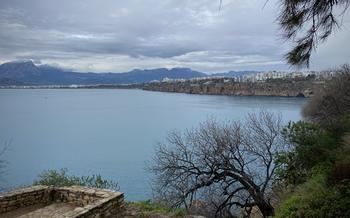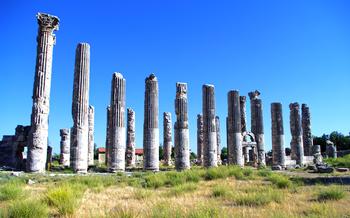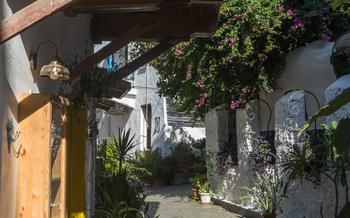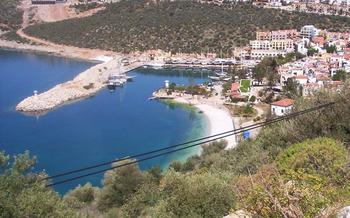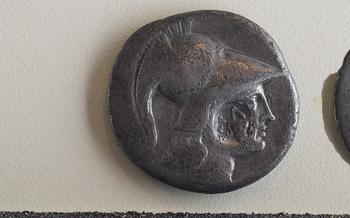
Apollo Temple in Side
- A Journey to Ancient Antiquity: Unveiling the Apollo Temple in Side
- Side's Architectural Masterpiece: A Legacy of Hellenistic Craftsmanship
- The Oracle of Apollo: Echoes of Prophecy and Divine Guidance
- Divine Abode: Exploring the Temple's Interior and Sacred Spaces
- Preserving the Legacy: Conservation and Restoration Initiatives
- Pilgrimage and Worship: Side as a Religious Center in Antiquity
- Unearthing the Past: Archaeological Excavations and Discoveries
- A Stroll Through History: Exploring Side's Ancient City Ruins
- Side's Stunning Setting: A Picturesque Seaside Haven
- Cultural Immersion: Exploring Side's Museum and Local Traditions
- Practicalities for Visitors: Planning Your Trip to the Apollo Temple
- Capturing the Essence: Photography and Visual Storytelling
- Educational Opportunities: Learning from the Past
- Side for History Buffs: Exploring Beyond the Apollo Temple
A Journey to Ancient Antiquity: Unveiling the Apollo Temple in Side
Nestled along the picturesque Mediterranean coast of Turkey, the ancient city of Side beckons visitors with its rich history and well-preserved ruins. Among its many architectural wonders, the Apollo Temple stands as a testament to the city's glorious past and its deep connection to Greek mythology. Built in the 2nd century AD, this magnificent temple dedicated to the revered Greek god Apollo has withstood the relentless passage of time, inviting travelers to embark on a journey through the annals of ancient history.
Side's Apollo Temple holds immense historical significance, as it served as a pivotal religious and cultural center during the Hellenistic and Roman periods. It was not merely a place of worship but also a venue for significant events, including religious festivals, oracles, and civic gatherings. The temple's enduring legacy lies in its exceptional preservation, thanks to meticulous restoration efforts that have ensured its remarkable condition for future generations to appreciate.
Side's Architectural Masterpiece: A Legacy of Hellenistic Craftsmanship
The Apollo Temple in Side stands as a testament to the exceptional craftsmanship and architectural prowess of the Hellenistic period. Constructed in the 2nd century BC, the temple showcases a harmonious blend of Greek and Anatolian architectural elements. Its sturdy construction features massive blocks of limestone, meticulously quarried and fitted together without the use of mortar. The temple's exterior is adorned with intricate carvings and bas-reliefs depicting scenes from Greek mythology, showcasing the skill and artistry of the ancient craftsmen.
One of the unique features of the Apollo Temple is its massive podium, which elevates the temple above the surrounding landscape, providing a commanding presence. The temple's façade boasts a row of elegant columns, each adorned with intricate capitals. The interior of the temple is divided into three distinct sections: the pronaos, the cella, and the adyton. The pronaos, or entrance porch, features a pediment with sculptures depicting Apollo and Artemis, reinforcing the temple's dedication to these deities.
The influence of Greek architecture is evident in the temple's overall design, particularly in the use of the Corinthian order for its columns. The Corinthian capitals, with their distinctive acanthus leaf ornamentation, add a touch of elegance and sophistication to the temple's exterior. The Apollo Temple in Side represents a remarkable fusion of Greek architectural elements with local Anatolian traditions, creating a unique and awe-inspiring monument that has stood the test of time.
The Oracle of Apollo: Echoes of Prophecy and Divine Guidance
In ancient Greek religion, oracles played a crucial role, serving as conduits between the divine and the mortal realms. The Oracle of Apollo at Side was one of the most renowned and influential oracles of its time. Believed to be the mouthpiece of the god Apollo, the oracle delivered prophecies and guidance to those who sought divine wisdom and counsel.
The oracular rituals were elaborate and intricate, often involving purification ceremonies, offerings to Apollo, and the interpretation of signs and omens. Devotees would pose their questions to the oracle, and the response, believed to be the direct words of Apollo, would be conveyed through a priest or priestess.
The interpretations of these oracles were highly influential, shaping political decisions, military strategies, and the lives of individuals. People from far and wide flocked to Side seeking guidance on matters of love, health, wealth, and destiny. The oracle's reputation for accuracy and wisdom attracted both commoners and rulers, who believed in the divine power of Apollo's prophecies.
Stories and legends abound about the oracle's uncanny ability to foresee the future. One tale tells of a wealthy merchant seeking advice on a business venture. The oracle warned him of impending financial ruin if he pursued his plans. Heeding the warning, the merchant averted disaster and later returned to Side to express his gratitude.
The Oracle of Apollo at Side was not just a sacred site but also a symbol of hope and divine guidance for the people of the ancient world. Its legacy continues to inspire awe and wonder, reminding us of the enduring power of faith and the search for answers beyond the realm of the mortal.
Divine Abode: Exploring the Temple's Interior and Sacred Spaces
The Apollo Temple in Side was not merely an architectural marvel but also a sacred space where religious rituals and ceremonies took place. The temple complex comprised various sections, each serving a specific purpose.
Entering the temple, visitors would first encounter the pronaos, a columned porch leading to the cella, the temple's inner sanctum. This sacred chamber housed the cult statue of Apollo, which was the focal point of worship. The statue, likely crafted from precious materials such as gold or ivory, was believed to be a representation of the god himself.
Within the cella, there were also altars where offerings were made to Apollo. These offerings could include libations, incense, or animal sacrifices. The temple also contained a treasury where valuable objects and donations were stored.
In addition to the main cella, the temple complex may have included other chambers for specific purposes, such as rooms for priests or storage spaces for ritual implements. These chambers would have been used to prepare for and conduct religious ceremonies and rituals honoring Apollo.
Understanding the layout and significance of the temple's interior spaces provides a deeper appreciation of the religious practices and beliefs of the ancient Greeks who worshipped Apollo in Side.
Preserving the Legacy: Conservation and Restoration Initiatives
The Apollo Temple in Side, a testament to ancient architectural prowess, has undergone significant preservation and restoration efforts to ensure its legacy endures for generations to come. Recognizing the importance of safeguarding this historical marvel, archaeologists and conservators have meticulously worked to restore the temple's grandeur while maintaining its authenticity.
Over the years, the temple has faced the ravages of time, natural disasters, and human neglect. Erosion, earthquakes, and centuries of exposure to the elements took their toll, leaving the temple in a state of disrepair. However, the dedication of experts in the field of restoration has brought new life to this ancient wonder.
Restoration efforts have focused on stabilizing the temple's structure, repairing damaged columns and walls, and reconstructing missing elements based on historical research and archaeological evidence. The use of traditional techniques and materials ensures that the temple retains its original character while preserving its integrity for future generations.
Ongoing projects continue to address the ongoing challenges of preserving the temple. Regular maintenance, monitoring, and research are essential to safeguard the structure from further deterioration. The dedication of conservators and archaeologists ensures that the Apollo Temple remains a symbol of Side's rich history and cultural heritage.
Pilgrimage and Worship: Side as a Religious Center in Antiquity
In ancient times, Side was renowned as a significant religious center, drawing pilgrims and worshippers from far and wide to pay homage to Apollo. The city was home to one of the most important oracles of the ancient world, dedicated to the revered deity. Devotees seeking guidance and divine prophecies flocked to Side, eager to hear the words of Apollo's oracle. The temple served as a sacred space where religious rituals, festivals, and ceremonies were held in honor of the god.
Throughout the year, numerous festivals and celebrations filled the air with music, dance, and offerings. These events showcased the deep devotion of the people and reaffirmed Side's status as a vital religious hub. The convergence of Greek and local Anatolian beliefs created a rich tapestry of religious practices and traditions, reflecting the diversity and tolerance that characterized ancient Side.
Unearthing the Past: Archaeological Excavations and Discoveries
The history of archaeological excavations at Side dates back to the late 19th century when European scholars began to explore the region. However, it was not until the mid-20th century that systematic excavations were undertaken by Turkish archaeologists. These excavations have yielded a wealth of artifacts and information, shedding light on the temple's history and significance.
One of the most significant discoveries was the unearthing of a large number of inscriptions, including dedicatory inscriptions, honorific inscriptions, and oracle texts. These inscriptions provide valuable insights into the religious practices and beliefs of the people of Side, as well as the role of the temple in the city's political and social life.
Another important discovery was the excavation of a large number of statues and other religious artifacts, including votive offerings, cult objects, and architectural elements. These artifacts provide tangible evidence of the temple's grandeur and the devotion of its worshippers.
The ongoing excavations at Side continue to reveal new and exciting information about the temple and its surroundings. In recent years, archaeologists have uncovered a number of previously unknown structures, including a monumental staircase leading up to the temple and a large courtyard used for religious ceremonies. These discoveries are helping to piece together the history of the temple and to better understand its role in the ancient city of Side.
A Stroll Through History: Exploring Side's Ancient City Ruins
Beyond the Apollo Temple, Side boasts a treasure trove of other ancient ruins and landmarks, inviting visitors to embark on a captivating journey through history. The ancient theater, a marvel of Hellenistic architecture, once hosted theatrical performances and public gatherings, its tiers of stone seats still echoing with the voices of the past. The agora, the bustling marketplace of ancient Side, offers a glimpse into the city's vibrant commercial life, with its well-preserved colonnades and shops. The city walls, with their imposing gates and towers, stand as a testament to Side's strategic importance and resilience.
Strolling through Side's ancient ruins is like stepping back in time, where every stone tells a story. Visitors can wander along the ancient streets, imagining the hustle and bustle of daily life in this thriving port city. Guided tours provide a deeper understanding of the history and significance of these remarkable sites, bringing the past to life. Combining visits to multiple sites allows visitors to piece together the rich tapestry of Side's ancient heritage, creating a comprehensive and immersive historical experience.
Side's Stunning Setting: A Picturesque Seaside Haven
The Apollo Temple in Side is not just a historical marvel; it is also situated in a breathtakingly beautiful location on the Mediterranean coast. The temple stands proudly against the backdrop of the azure waters, creating a picturesque vista that will take your breath away. The temple's location offers stunning views of the sea, the coastline, and the surrounding landscape.
Take a stroll along the promenade that runs alongside the temple and enjoy the refreshing sea breeze. Capture the beauty of the temple from different angles, with the sparkling sea as its backdrop. The temple's setting provides an ideal opportunity to combine history and nature in one unforgettable experience.
After exploring the temple, you can relax and rejuvenate on one of Side's beautiful beaches. Take a dip in the crystal-clear waters, soak up the sun's warmth, and enjoy the tranquility of this seaside paradise. The combination of ancient history and natural beauty makes Side a truly special destination that offers something for everyone.
Cultural Immersion: Exploring Side's Museum and Local Traditions
Enrich your understanding of Side's rich history and cultural heritage by visiting the Side Museum, a treasure trove of artifacts and exhibits that tell the story of this ancient city. Immerse yourself in the local traditions by engaging with traditional crafts, savoring the delectable cuisine, and participating in vibrant festivals. Embrace the warmth and hospitality of the Turkish people, who are known for their welcoming nature and respect for customs. Remember to be mindful and respectful of local traditions and customs, ensuring that you contribute positively to the cultural exchange.
Practicalities for Visitors: Planning Your Trip to the Apollo Temple
Planning a visit to the Apollo Temple in Side requires some practical considerations. The temple is situated in the heart of the ancient city, within easy reach from Side's modern center. It is open to the public daily, with admission fees that are affordable and contribute to the temple's preservation efforts. To make the most of your visit, plan your trip carefully, considering the time of day and year. The temple's golden hour, just before sunset, offers magical lighting conditions for photography and a serene ambiance. During the summer months, temperatures can soar, so early mornings or late afternoons are ideal for avoiding the heat. Remember to dress respectfully when visiting the temple, as it is a sacred site.
Capturing the Essence: Photography and Visual Storytelling
The Apollo Temple in Side is a feast for the eyes, and capturing its beauty through photography is a rewarding experience. To make the most of your photographic journey, consider these tips:
-
Seek the Golden Hour: The golden hour, just after sunrise or just before sunset, offers the most flattering light for photography. The warm, diffused light casts a magical glow on the temple, enhancing its architectural details and creating a sense of depth.
-
Explore Different Perspectives: Don't limit yourself to frontal shots. Experiment with different angles and vantage points to capture the temple's grandeur. Try shooting from below to emphasize its towering presence or from a distance to capture its setting against the Mediterranean backdrop.
-
Play with Shadows and Silhouettes: The temple's columns and sculptures cast dramatic shadows at certain times of the day. Use these shadows to create interesting compositions and add depth to your photos. Silhouettes against the golden sky can also be striking.
-
Capture the Temple's Story: Beyond capturing its physical beauty, strive to convey the temple's history and significance through your photographs. Look for details that hint at its ancient rituals, such as altars, inscriptions, or religious artifacts.
-
Share Your Visual Stories: Share your stunning temple photos on social media platforms like Instagram or photography-sharing websites. Use relevant hashtags to connect with other photography enthusiasts and share your passion for ancient history and architecture.
Educational Opportunities: Learning from the Past
The Apollo Temple in Side offers a wealth of educational opportunities for visitors of all ages. Educational programs and workshops related to the temple are regularly organized, providing insights into its history, architecture, and religious significance. These programs often feature lectures by historians, archaeologists, and other experts, who share their knowledge and research findings with participants.
Opportunities for students and researchers are also available at the temple. The site serves as a field research station for universities and institutions, allowing students to conduct archaeological excavations, study ancient artifacts, and contribute to the ongoing understanding of the temple's past.
Engaging with historians and archaeologists at the temple provides visitors with a unique chance to learn firsthand from the experts who have dedicated their lives to studying and preserving this ancient site. These interactions promote cross-cultural understanding and foster a deeper appreciation for the rich history of the region.
Whether through educational programs, workshops, or direct engagement with experts, the Apollo Temple in Side offers visitors the chance to delve deeper into the past and gain a comprehensive understanding of this remarkable ancient site.
Side for History Buffs: Exploring Beyond the Apollo Temple
While the Apollo Temple stands as a testament to Side's rich past, the city and its surrounding region offer a wealth of other ancient treasures waiting to be discovered. History buffs can embark on a journey through time, exploring the ruins of once-thriving cities, marveling at awe-inspiring theaters, and tracing the footsteps of ancient civilizations.
Just a short distance from Side, visitors can step into the ancient city of Perge, where monumental gates, colonnaded streets, and a well-preserved theater transport them back to the Roman era. Aspendos, another nearby gem, boasts one of the best-preserved Roman theaters in the world, renowned for its exceptional acoustics and architectural grandeur.
Venturing further afield, travelers can uncover the secrets of Termessos, a spectacular mountaintop city nestled amidst the Taurus Mountains. Its remote location and well-preserved ruins offer a glimpse into the lives of the Pisidian people, who fiercely resisted foreign rule.
Exploring these ancient sites in conjunction with Side's Apollo Temple provides a comprehensive understanding of the region's fascinating past. History enthusiasts can craft itineraries that delve into different periods and aspects of ancient history, creating a truly immersive and educational experience.
